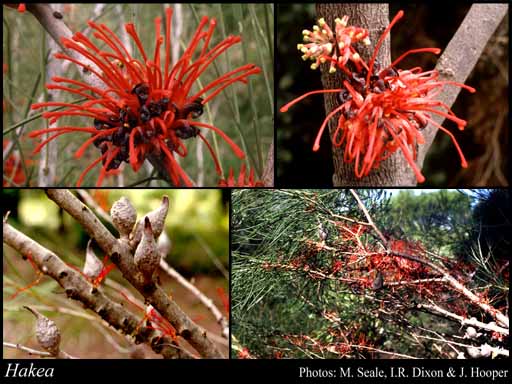- Reference
- Sertum Hannoveranum p27, t. 17. (1796)
- Name Status
- Current







Scientific Description
Common name. Hakeas. Family Proteaceae.
Habit and leaf form. Small trees, or shrubs; evergreen. Mesophytic, or xerophytic. Heterophyllous, or not heterophyllous. Leaves small to medium-sized; alternate; usually spiral; leathery; petiolate, or sessile; non-sheathing; aromatic, or without marked odour; edgewise to the stem, or with ‘normal’ orientation; simple; epulvinate. Leaf blades isobilateral, or centric; usually entire, or dissected; flat, or solid; terete; elliptic, or ovate, or obovate, or linear, or orbicular; when simple/dissected dichotomously dissected, or much-divided, or spinose. Leaves without stipules. Leaf blade margins entire, or dentate. Leaves without a persistent basal meristem. Leaf anatomy. Hairs present, or absent. Stem anatomy. Secondary thickening developing from a conventional cambial ring.
Reproductive type, pollination. Fertile flowers hermaphrodite. Unisexual flowers absent. Plants hermaphrodite. Entomophilous, or ornithophilous, or pollinated by unusual means (by small marsupials).
Inflorescence and flower features. Flowers aggregated in ‘inflorescences’. Inflorescence few-flowered, or many-flowered. Flowers in pairs, subtended by a common bract; in racemes. The terminal inflorescence unit racemose (or two flowered). Inflorescences axillary, or terminal (rarely); of solitary racemes, often very condensed, generally referred to as axillary clusters; without involucral bracts; pseudanthial, or not pseudanthial. The fruiting inflorescence not conelike. Flowers pedicellate (to almost sessile); bracteate; small to large (often very showy); regular to very irregular; when irregular, zygomorphic. The floral asymmetry when present, involving the perianth and involving the androecium. Flowers mainly 4 merous; cyclic; tetracyclic, or tricyclic. Floral receptacle developing a gynophore, or with neither androphore nor gynophore. Free hypanthium absent. Hypogynous disk present; extrastaminal; in the form of a broad gland, adaxial to the ovary. Perianth of ‘tepals’; 4; 1 -whorled; joined (shorter than or rarely as long as gynoecium; claw usually opening before the limb; limb usually recurved, globular or ovoid); green, or white, or cream, or yellow, or red, or pink, or purple, or brown. Androecium 4. Androecial members adnate; all equal, or markedly unequal; free of one another; 1 -whorled. Stamens 4; isomerous with the perianth; filantherous, or with sessile anthers (or subsessile). Anthers cohering, or connivent, or separate from one another; more or less basifixed; non-versatile; dehiscing via longitudinal slits; introrse; four locular; tetrasporangiate; appendaged (? via the elongated connective), or unappendaged. Gynoecium 1 carpelled. The pistil 1 celled. Gynoecium monomerous; of one carpel; superior. Carpel fully closed, or incompletely closed; stylate; apically stigmatic; 2 ovuled. Placentation marginal (? mostly), or apical. Ovary stipitate (but usually only very shortly so). Ovules funicled, or sessile; non-arillate; orthotropous, or anatropous, or amphitropous, or hemianatropous.
Fruit and seed features. Fruit persistent; non-fleshy (woody). The fruiting carpel dehiscent; a follicle. Follicles compact; without septa. Gynoecia of adjoining flowers combining to form a multiple fruit, or not forming a multiple fruit. The multiple fruits coalescing, or not coalescing. Fruit 2 seeded. Seeds non-endospermic; compressed; winged. Seed wings not encircling body (wing membranous, terminal, often decurrent), or encircling body (rarely). Embryo well differentiated. Cotyledons 2(–8). Embryo straight. Testa often with protuberances on the outer surface.
Special features. Stamens inserted within a concavity near the end of a perianth segment. Leaf blades terete, or upper and lower surfaces similar.
Geography, cytology, number of species. Native of Australia. Endemic to Australia. Australian states and territories: Western Australia, South Australia, Northern Territory, Queensland, New South Wales, Victoria, Australian Capital Territory, and Tasmania. Northern Botanical Province, Eremaean Botanical Province, and South-West Botanical Province.
Etymology. After Christian Ludwig, Baron von Hake (1745–1818), German patron of botany.
Taxonomic Literature
- George, Alexander S.; Barker, Robyn M. 2007. Hakea chromatropa (Proteaceae: Grevilleoideae), an apparently rare new species from Western Australia.
- Hollister, Chris; Lander, Nicholas 2007. Western Australian Proteaceae : interactive identification & information retrieval : Banksia & Dryandra, Conospermum, Grevillea, Hakea, Isopogon & Petrophile. Western Australian Herbarium.. [Kensington, W.A.]..
- Wheeler, Judy; Marchant, Neville; Lewington, Margaret; Graham, Lorraine 2002. Flora of the south west, Bunbury, Augusta, Denmark. Volume 2, dicotyledons. Australian Biological Resources Study.. Canberra..
- Australian Biological Resources Study 1999. Flora of Australia. Volume 17B, Proteaceae 3, Hakea to Dryandra. CSIRO Publishing.. Canberra..
- Barker, R. M. 1998. The Hakea pedunculata group of species (Proteaceae) and a new subspecies of Hakea stenophylla from Western Australia.
- Young, Jennifer 1997. Hakeas of Western Australia : botanical district of Avon, the wheatbelt. W.A. National Parks & Reserves Association.. Maylands, W.A..
- Barker, W. R. 1996. Novelties and taxonomic notes relating to Hakea sect. Hakea (Proteaceae), mainly of eastern Australia.
- Barker, R. M. 1990. New species, new combinations and other name changes in Hakea (Proteaceae).
- Blackall, William E.; Grieve, Brian J. 1988. How to know Western Australian wildflowers : a key to the flora of the extratropical regions of Western Australia. Part I : Dicotyledons (Casuarinaceae to Chenopodiaceae). University of W.A. Press.. [Perth]..
- Lamont, Byron; Keighery, Bronwen; Penny, Linda; Wallace, John 1987. A numeric, geographic and structural analysis of the Hakea falcata group (Proteaceae).
- Marchant, N. G.; Wheeler, J. R.; Rye, B. L.; Bennett, E. M.; Lander, N. S.; Macfarlane, T. D.; Western Australian Herbarium 1987. Flora of the Perth region. Part one. Western Australian Herbarium.. [Perth]..
- Rye, B. L. 1984. A new species and a new combination among the Proteaceae represented in the Perth region.